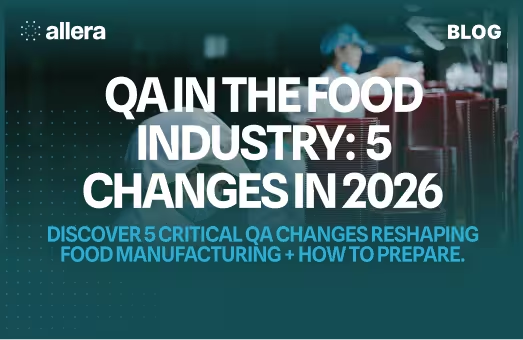

Food Traceability: Ultimate 2025 Food Manufacturing Guide

Key Takeaways
- Act fast on contamination to prevent illness, reduce recalls, and protect your brand.
- Prepare early for FDA compliance ahead of the July 20, 2028 Food Traceability Final Rule deadline.
- Leverage modern traceability tools like barcodes, RFID, blockchain, and IoT for better visibility.
- Overcome adoption barriers with phased rollouts and strong staff training.
- Use detailed tracking to strengthen FSQA, speed up audits, and build consumer trust.
Below, you'll discover an in-depth look at food traceability: how it works, why it matters in food safety, and how to put it to work in your facility. You'll also learn about key technologies, regulatory updates, and practical ways to overcome the challenges that commonly arise. By the time you finish, you'll have the framework to protect public health, meet stringent standards, and strengthen your brand's reputation.
What is Food Traceability?
Food traceability is, at its core, the ability to follow each product's journey across production, processing, and distribution. You want to see exactly where every batch came from, how it was handled, and who touched it along the way.
A joint effort from multiple organizations, including the FDA and industry leaders, shows that once contamination occurs, immediate traceability can significantly minimize foodborne illnesses. According to the FDA, thorough tracing helps coordinate efficient recalls, sometimes pinpointing the affected items within hours rather than days. This fast response can save both lives and resources.
Why Food Traceability Matters
Protect Public Health. Swift, accurate tracking means you can isolate contaminated batches quickly and remove them before anyone gets hurt.
Comply with Regulations. Post-COVID-19 measures have increased scrutiny on supply chain transparency (FDA FSMA). Traceability is no longer just a best practice; for most segments of the industry, it is required.
Build Consumer Trust. When customers know you follow robust safety measures, they feel reassured. This trust is invaluable for any brand.
How Does Food Traceability Works?
Effective traceability follows each Critical Tracking Event (CTE), a term the FDA uses for major handoffs in the chain—like shipping, receiving, and transformation of food. You or your partners record Key Data Elements (KDEs) at each point, including unique lot codes, processing dates, and shipping details. At any time, you can retrieve this data to verify product origins or recall specifics.
A growing number of manufacturers rely on food traceability software to automate much of this work. Such technology collects KDEs from every step in the process, stores them in a central database, and helps you retrieve that info fast, no matter how many lots or shipments you manage daily.
Regulations That Affect Food Traceability
Today's compliance environment is shaped by legislative milestones that prioritize transparency and accountability. Understanding these frameworks will guide you toward robust interventions.
U.S. Food Safety Modernization Act (FSMA)
Signed into law in 2011, FSMA propelled a new era in food safety, requiring enhanced recordkeeping for high-risk foods, like leafy greens. Subsequent updates in 2022 introduced traceability mandates for fresh produce, seafood, eggs, and more (FDA Food Traceability Rule). If you manage any of these products, you're expected to gather and maintain records for up to two years.
In practice, ensuring you meet FSMA traceability rules may involve pursuing FSMA certification. While certification isn't always mandatory for every facility, it's a strong signal that you follow rigorous procedures to protect the food chain.
Food Traceability Final Rule (FSMA 204)
The FDA's Food Traceability Final Rule (FSMA 204), originally set for compliance by January 20, 2026, is now tentatively extended to July 20, 2028 (FDA). This extension aims to give you and other stakeholders time to develop robust solutions for capturing and maintaining data. During each step—harvesting, cooling, packing, shipping, and receiving—you'll need to assign and track specific lot codes. Then, you must share these codes if the FDA requests them.
The extra 30 months help smaller or resource-limited operators meet new data-sharing obligations. Still, experts advise starting early. Good news: by tackling the requirements now, you'll strengthen your processes and sleep better knowing you're well prepared before the new deadline arrives.
If this deadline is important for you, or your looking for better ways to stay FSMA compliant, check out or comprehensive list of the 10 best FSMA compliance software in 2025.
Other Global Frameworks
Traceability is hardly unique to the United States. If you're an international exporter or you source ingredients globally, you may also have to meet:
European Union's General Food Law. Mandatory labeling and traceability for all food products and feed since 2002 (EUROPA Food Safety).
Region-Specific Rules. Different countries impose additional or stricter rules on tagging, coding, and transport. Staying informed of local updates is crucial.
Adopt Helpful Tools
With regulations tightening, advanced tools have become the backbone of traceability. Leveraging the right technology saves time, cuts cost, and fortifies compliance.
Barcode Scanning and RFID
Barcode scanning is one of the simplest checkpoints in traceability. It lets you scan items at each step for a quick record of their movement. For more sophisticated needs, radio-frequency identification (RFID) uses tags that can be read remotely, even if your product is packed or stacked. RFID is particularly useful in large warehouses where manual scanning might be slow.
Still, not every enterprise needs RFID. Cost, complexity, and the volume of goods play a role in deciding whether you should upgrade from standard barcodes. If your operations run on a smaller scale or you have a streamlined supply chain, barcodes might suffice. For bigger facilities, especially those that handle sensitive items, RFID can offer an extra layer of coverage and real-time visibility (GS1).
Blockchain for Transparency
Blockchain technology, an immutable digital ledger, is emerging as a popular method for ensuring data integrity. Once recorded, transaction logs are nearly impossible to alter. For you, that means any modifications to product info—like farm location or temperature readings—become part of a permanent chain of records. Major retailers have used this method to reassure customers about product origins and speed up recalls when safety issues arose.
Before you dive into blockchain, consider the initial investment and the training required for all partners to use it effectively. Having strong buy-in from every node in your supply chain is vital. Otherwise, you might collect partial data that fails to provide full transparency.
IoT Sensors
Internet of Things (IoT) devices, such as smart sensors and GPS trackers, offer real-time insights into temperature, humidity, and location. For perishable goods, small changes in storage environment can make or break product safety. By equipping your trucks and warehouses with these sensors, you'll know exactly when and where a shipment fell outside ideal conditions—and can act before it spoils precious inventory.
IoT solutions are particularly valuable in dairy, seafood, and other temperature-sensitive categories. Research shows that firms have improved cold chain reliability by 30% using real-time notifications from IoT sensors. If a refrigeration unit malfunctions, the sensor sends an alert immediately, giving managers time to fix the problem before risking contamination or spoilage.
Food Traceability Software
While specific hardware like scanners and sensors play a key role, software ties the entire ecosystem together. Automated solutions:
- Unify Data Capture. Software centralizes info, from raw materials intake to finished product shipping.
- Simplify Compliance Reporting. With pre-built templates for major regulations, you can generate the records required for FSMA certification.
- Track Inventory and Production. Real-time dashboards ensure you know where each lot is, who handled it, and when it's headed out.
When linked with your food quality management system, these platforms can boost safety procedures, identify bottlenecks, and manage recall scenarios in minutes instead of days. Good news—many of these software suites are modular, letting you start small and expand as your needs grow.
Challenges in Food Traceability (With Solutions)
Despite the clear benefits, many food manufacturers struggle to establish a fully traceable supply chain. Being aware of the hurdles can help you plan around them.
Complexity and Fragmentation
If you rely on multiple raw material suppliers scattered across different regions, unifying your data can become daunting. According to GFSI, every additional link in the supply chain potentially adds confusion, especially if partners operate outdated systems. Building a standardized data exchange protocol—whether via EDI, cloud-based portals, or CSV uploads—closes these communication gaps.
Tech Readiness
Some small and midsize enterprises (SMEs) hesitate to adopt advanced systems like blockchain or IoT due to costly investments and the learning curve. If you fall into this category, consider a phased approach:
- Start with barcodes or basic software to build your data foundation.
- Add sensors or an ERP module once you're comfortable with daily operations.
- Explore advanced features—machine learning or predictive analytics—only after you've stabilized your initial traceability processes.
Data Security and Privacy
Managing large volumes of supply chain data involves handling proprietary information—recipes, price points, and distribution routes. Ensuring robust cybersecurity is critical. Unauthorized access can not only compromise business strategy but also hamper trust. Review your data protection measures regularly and see if your local regulations require specific encryption or additional controls.
Cultural Resistance
Improving traceability can feel like extra work to staff and suppliers. You may encounter pushback from line workers or vendor partners unsure of the benefits. Here's where transparency and training matter. Show real examples of how traceability can prevent public health crises, protect brand image, and reduce compliance anxiety. When everyone sees the bigger picture, they're more willing to contribute accurate data.
Inconsistent Standards
Around the globe, countries enforce slightly different recordkeeping thresholds. Even within the same region, you might see variations in data formatting. The FDA recognized this challenge and extended the Food Traceability Final Rule compliance date to give businesses time to standardize. However, waiting too long could mean a compliance scramble. Spare yourself future headaches by mapping out each regulation your business must meet—then build a single interface that captures data for all required formats.
Elevate Your Compliance
Compliance with government and industry standards is not just about avoiding penalties; it's a critical piece of brand credibility. Whether you need to pass a BRC audit or a regulatory inspection, traceability is your first line of defense.
Align Traceability with FSQA
Food Safety and Quality Assurance (FSQA) aims to create a consistent, top-quality product that poses minimal risk to consumers. Traceability is the engine that drives FSQA success. By logging every ingredient and step, you can:
Verify Quality Inputs. Know each supplier's track record and confirm that materials meet specifications.
Flag Deviations Quickly. Spot unusual fluctuations in temperature or usage rates, alerting you to potential hazards.
Support Audits and Inspections. With a transparent chain of custody, your next visit from a food inspector becomes easier and faster.
Combine Monitoring and Testing
Even with perfect record keeping, you still need robust food safety testing at critical points to catch pathogens or contaminants. Each lab result, whether in-house or third-party, should tie back to the product's lot code. If testing reveals a danger, your traceability system can locate the affected batch immediately and pull it from distribution.
Embrace a Culture of Improvement
Maintaining compliance is not a one-off project. Think of it as a cycle of continuous improvement:
- Develop a plan that meets standards for each region where your products ship.
- Train your staff and supply chain partners.
- Conduct periodic mock recalls or audits.
- Gather feedback, refine processes, and implement new tools as regulations change.
Good news—this cycle keeps your facility fresh and agile, ready to handle new market opportunities, expansions, and changes in consumer demands.
Final Thoughts
Food traceability can be a transformative force for your facility. When you know exactly where each product comes from, you protect consumers, meet global regulations, and ultimately elevate your reputation in a crowded marketplace. If you're looking for deeper insights or specialized guidance, reach out to Allera Technologies—leaders in supporting organizations with food safety innovations.
By taking purposeful steps toward automated recordkeeping, robust monitoring, and coordinated supplier relationships, you set yourself up for success in 2025 and beyond. With clear data, balanced practices, and an unwavering focus on each step of your supply chain, you'll be ready for whatever the future of food manufacturing brings.
FAQs
What are examples of traceability?
Examples of traceability include batch or lot numbers on packaging linked to production records, QR codes that provide consumers with origin and handling history, and digital records tracking every stage of the supply chain. These tools improve food safety management and build consumer trust.
What are the three types of traceability?
The three main types of traceability are: Internal Traceability (tracking products within a single organization), External Traceability (tracking products moving between supply chain partners), and Full Chain Traceability (combining internal and external to monitor the entire supply chain from origin to consumer). Implementing all three types ensures complete visibility and control.
Is traceability part of HACCP?
Yes, traceability is a vital component of HACCP (Hazard Analysis and Critical Control Points). It supports identifying and controlling hazards by enabling the tracking of food products through all production and distribution stages, allowing rapid response to safety incidents and ensuring effective food safety management.
What is an example of traceability in the food industry?
A common example of traceability is tracking a batch of lettuce from the farm to the retail store. Every step—including harvesting, processing, packaging, and distribution—is documented. This enables quick identification of contamination sources and efficient recalls when food safety issues arise.
What is the traceability rule in Florida?
Florida follows the federal FDA traceability regulations and enforces additional state-specific requirements, especially for seafood and agriculture products. Food businesses in Florida must maintain accurate and accessible traceability records to comply with both federal and state laws, ensuring full transparency from farm to consumer.
What is the FDA food traceability rule?
The FDA Food Traceability Rule, finalized in 2022, requires enhanced traceability for certain high-risk foods throughout the supply chain. This regulation helps speed up and improve the accuracy of identifying contamination sources during foodborne illness outbreaks, allowing faster, targeted recalls to protect consumers and public health.




.avif)


.avif)
.avif)

